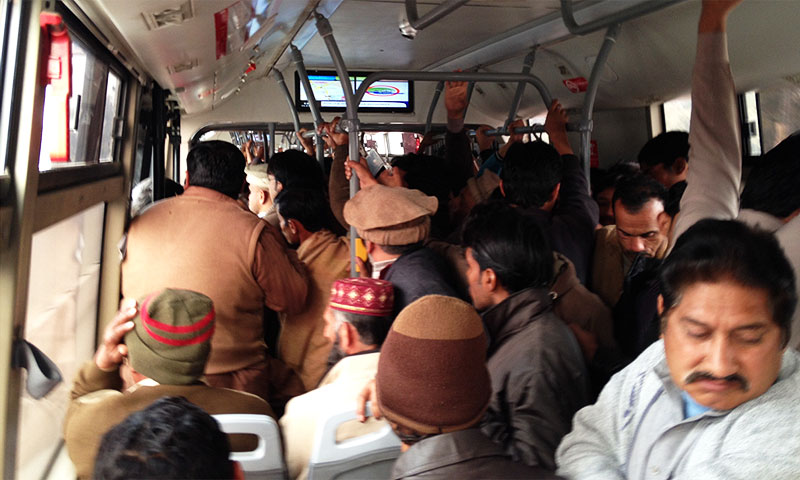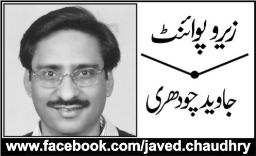A professionally managed and efficiently delivered public transit service has been a dream of urban residents in Pakistan. The dream though came true for 140,000-plus Lahoris who enjoy an efficient, reliable, and sustainable public transit service made possible by the Lahore Bus Rapid Transit (BRT).
Running along Ferozepur Road connecting Shahdara with GujuMatta, the 27-kilometre long Lahore BRT is the first-ever high-capacity urban transit system in Pakistan that has been designed and operated by transit professionals. Transit planning and service delivery in Pakistan have been the exclusive domain of transit quacks who neither had the capacity nor the willingness to deliver efficient transit service. This has all changed with the Lahore BRT, which is operated by professional private sector operators, while the system is managed and monitored by professional transit planners. No wonder the buses run on time and offer a reliable and courteous service.
While in its present incarnation, the Lahore BRT system is far from perfect. It is, in fact, a work in progress where a single route will have to be developed into an integrated transit network. In spite of the obvious shortcomings, the Lahore BRT offers a great lesson: If there is political will, mountains can be moved. The BRT system, with elevated right-of-way, was built in a record time of 11 months, something other cities in Pakistan have not been able to achieve in 67 years.
Recent criticism of the Lahore BRT system in popular press does disservice to this particular socio-political achievement in Lahore for several reasons. First, the criticism is contextualized in populist diatribe instead of being informed by public transit key performance indicators. Second, the author confuses the BRT with regular or para transit, which are two distinct transit systems with very different operating characteristics and cost structures. The author criticises the cost of the BRT system as he converts the total cost into cost per operating bus. This is a poor metric to use with the BRT system that has the capacity to carry three-times more passengers with the same high-quality operating characteristics.
Let me offer the analogy of a dispensary and a sophisticated hospital to explain the difference between the BRT and regular bus service. The dispensary, like the regular bus transit, offers the bare minimum service and is operated by a semi-trained individual. The hospital, on the other hand, employs surgeons and runs state-of-the-art operating theatres. It should not come as a surprise that the cost per patient served at the hospital will be an order of magnitude higher than the cost per patient served by the dispensary. If the BRT's criticism of high cost is deemed credible, which should not be the case, then one would rather shutdown all hospitals and replace them with dispensaries for their low operating cost structures.
The BRT is expensive to build and operate because of investments required for constructing the exclusive right-of-way and a modern command and control system to be operated by highly trained staff. Where else in Pakistan do we have professionals with Masters and Doctorates in transportation planning and engineering from prestigious universities operating urban transit?
The Lahore BRT is being operated by a team of specialists who monitor each and every operating bus in real-time from a state-of-the-art transit control centre that competes in quality with other similar centres in the western world. The fact that during peak demand hours buses arriving at a three-minute frequency or less is a direct result of professional planning and delivery.

The Lahore BRT filled to capacity on January 14 (12 Rabiul Awwal) at 11:00am heading to Gajjumata from MAO College. -Source: Murtaza Haider.
Earlier in January, I had the opportunity to study the Lahore BRT system to appreciate its operating characteristics. I rode the BRT system in both directions. I visited the transit control centre to meet with the professionals who monitor each bus operating in the network. I spoke with the sanitary staff that was keeping the transit system free of refuse and garbage. I interviewed the ticketing and maintenance staff at bus stations and those operating the back-up generators. I also met with urban and transport planners who have been working for years to plan this system. My conclusion: The BRT system is a great success and a great beginning for efficient urban transit service delivery in Pakistan. Instead of being shunned, it needs to be replicated across Pakistan.
I have analyzed and written about transit systems for over 20 years. In fact, theWoodrow Wilson Centre for International Scholars published this week a policy brief I authored on transport planning imperatives for Pakistan. My experience to date allows me to appreciate the BRT's strengths and to criticise its shortcomings. The BRT's greatest strength is its potential to serve as the prototype for transit planning and delivery in Pakistan where most infrastructure funds have historically been spent on facilitating travel by car. Motorways, over and underpasses, and ring roads and bypasses are examples of conventional urban transport spending. Regrettably, examples of spending on transit and pedestrian or bike infrastructure have been rare. The Lahore BRT allows other local and provincial governments in Pakistan to appreciate an alternative format of transport spending that helps improve mobility for the majority of commuters in Pakistan who do not own a car.
The Lahore BRT system does have limitations. Given that it essentially operates in a single corridor, it lacks the utility offered by a networked transit system. Transit planners in Lahore though are working on expanding the BRT network to other busy corridors. Its current fixed fare of 20 rupees per ride encourages long-distance commuters, while discouraging short-distance commuters. A zone-based transit fare would encourage more short-distance trips resulting in greater turnover of seats and higher revenue.
The transit system is reachable by stairs or escalators, which violates principles of universal design. Adding elevators will make the transit system accessible to those in wheelchairs and others with special needs. The access and egress points are not well-integrated with adjacent land uses. At the Gajjumata station, commuters climb down on a landing that is arbitrarily placed between the main and the service roads, thus requiring the commuters to step onto the road first to reach the sidewalk.

Staircases could become hurdles for seniors and others with restricted mobility options. -Source: Murtaza Haider.
Despite its limitations, those who ride the BRT system in Lahore know that other modes of travel cannot offer stable operating speeds of 45 to 60 km/hour during peak and off-peak periods. This is a direct result of the exclusive (and mostly elevated) right-of-way and signal priority for buses at intersections where BRT vehicles compete for space in mixed traffic. The exclusive right-of-way is what differentiates a BRT system from an ordinary bus transit system. The fact that the transit vehicles do not compete with other mixed traffic allows transit to operate at faster speeds and offer reliable service. This gives transit the competitive advantage over private cars that eventually results in a modal shift from car to public transit.
The Lahore BRT system has been designed with excess capacity. Each station is equipped with three loading docks to simultaneously handle three articulated buses. Similarly, the transit control centre has the capacity to monitor and control several transit corridors. As the transit use matures in Lahore, the BRT service along Ferozepur Road should be able to carry up to 10,000 passengers per hour per direction from current loadings of approximately 7,000 passengers per hour per direction.
The question to ask is how does Lahore's BRT compare in throughput capacity against other transit systems. One can deploy two metrics used in the transit industry. For transit riders per corridor, the Lahore BRT with approximately 140,000 riders per day measures up well. However, for approximately 5,000 transit riders per km of network, Lahore's BRT is at the lower end of the BRT spectrum. The second metric can be improved by fixing the fare structure so that long-distance commuters pay more than short-distance commuters. This will result in a larger number of riders per available seat in the corridor. Furthermore, as the network is expanded to other busy corridors in Lahore, such as Multan Road, transit demand is likely to increase across the network.
At the Second Pakistan Urban Forum in Karachi earlier in January, I witnessed the enthusiasm of urban planning colleagues from Karachi, Peshawar, and other large urban centres in Pakistan for the BRT system in Lahore. Large urban centres are struggling with traffic congestion. However, traffic gridlock should not be a forgone conclusion for large cities in Pakistan. A combination of smart investments in transit and other infrastructures can improve mobility in Pakistani cities.
Strategic investments in BRT systems in Ahmedabad (India), Bogota (Columbia), Curitiba (Brazil), and Ottawa (Canada) have shown that bus-based transit can deliver efficient and sustainable transit service at a fraction of a cost of doing the same with underground rail-based systems. The Lahore BRT is a welcome addition to successful bus-based transit systems. Lahoris should be thanked for showing the rest of the country a better way to move people and economy.
Murtaza Haider is a Toronto-based academic and the director of Regionomics.com.










































.jpg)
